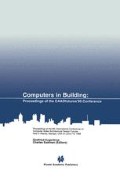Abstract
This paper describes the results of a longer-term research project that looked at CAAD as an enabler of completely new collaborative processes rather than as a support for existing collaborative processes. In order to question existing design processes and invent new collaborative processes systematically, we applied a process modeling methodology that employed recent developments in coordination theory. The methodology contained four steps: (1) Decomposition, (2) Dependency Analysis, (3) Process Substitution, and (4) Recomposition. In this paper, we describe how this approach was used to redesign a sample collaborative design process in building design, and present the resulting process coordination model. We describe the implications of this model for the development of collaborative environments, and illustrate its practical application in a case study. We conclude by reiterating the contributions made.
Access this chapter
Tax calculation will be finalised at checkout
Purchases are for personal use only
Preview
Unable to display preview. Download preview PDF.
References
Bakos, Y. N., “A strategic analysis of electronic marketplaces,” MIS Quarterly, 15,3 (1991), pp. 295–310.
Bakos, J.Y., and Pollalis, S.N., A Framework for the Design Process, No. LCT-87-2, Harvard University Graduate School of Design, Cambridge, MA, November 1987.
Booch, G., Object-oriented analysis and design with applications, Redwood, CA: Benjamin/Cummings Publishing, 1994.
Chen, P.P.S., “The entity-relationship model: Toward a unified view of data,” ACM Trans. Database Syst., 1,1, pp. 9–36, 1976.
DeWitte, P., Pourteau, C., “IDEF enterprise engineering methodologies support simulation,” Manufacturing Systems: Information Technology for Manufacturing Managers (March 1997), pp. 70–75
Kolarevic Branko, Schmitt G., Hirschberg U., Kurmann D., Johnson B., An Experiment in Design Collaboration, in Proceedings of (CD): ACADIA’ 98 conference, Quebec City, October 22–25, 1998
Huang, J., Interorganizational Information Systems in Design, Doctoral Dissertation, University Microfilms International, Ann Arbor, Michigan, 1997.
Huang, J., and S. N. Pollalis, “Knowledge, Agency, and Design Information Systems,” in R. Junge (ed.), CAAD Futures’ 97, Kluwer Academic, Dordrecht, Netherlands, 1997.
Jeng, T., and C. M. Eastman, “A Database Architecture for Design Collaboration”, Proceedings of TeamCAD Workshop on Collaborative Design, Atlanta, May, 1997.
Junge, R. (ed.). CAAD Futures 1997, Dordrecht: Netherlands: Kluwer Academic Publishers, 1997.
Malone, T.W., and Crowston, K., “The interdisciplinary study of coordination,” ACM Computing Surveys, 1994 (March), 26(1), 87–119.
Malone, T.W., Crowston, K., Lee, J., and Pentland, B., ”Tools for inventing organizations: Towards a handbook of organizational processes,” Working Paper, Cambridge, MA: MIT Center for Coordination Science, 1993.
Martin, J., Object-Oriented Analysis and Design, Englewood Cliffs: Prentice Hall, 1992.
Pollalis, S.N., “Towards the Automation of Conceptual Design,” In Tzonis, A., and White, I. (eds.), Automation Based Creative Design: Current Issues in Computers and Architecture, Amsterdam: Elsevier, 1993.
Schmitt G., Architektur mit dem Computer, Vieweg Verlag, Wiesbaden, Oktober 1996
Wojtowicz, I. (ed.) Virtual Design Studio. Hong Kong: Hong Kong University Press, 1994.
Yourdon, E., Modern Structured Analysis, Englewood Cliffs, Prentice-Hall, 1989.
Author information
Authors and Affiliations
Editor information
Editors and Affiliations
Rights and permissions
Copyright information
© 1999 Springer Science+Business Media New York
About this chapter
Cite this chapter
Huang, J. (1999). How do distributed design organizations act together to create a meaningful design?. In: Augenbroe, G., Eastman, C. (eds) Computers in Building. Springer, Boston, MA. https://doi.org/10.1007/978-1-4615-5047-1_7
Download citation
DOI: https://doi.org/10.1007/978-1-4615-5047-1_7
Publisher Name: Springer, Boston, MA
Print ISBN: 978-1-4613-7294-3
Online ISBN: 978-1-4615-5047-1
eBook Packages: Springer Book Archive

